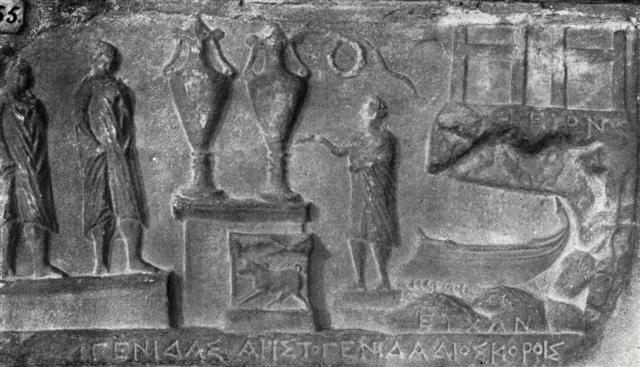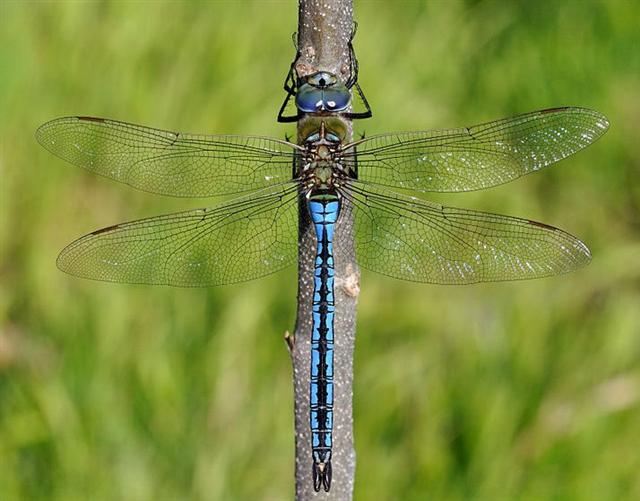|
3. The reason for H H instead of a single modified Π with a pair of cross-beams at the top probably was to indicate that there were twin doors, one for each twin. And this could not be visualized by Π Π because it would be misleading. Why? Because the Gemini twins were at that time no longer emerging at spring equinox but at the time when the 'cup' part of the year began. Π is standing on the ground and by instead choosing H it became clear that the opening was below ground. The high declination of Gemini was irrlevant, it was the right ascension which counted - not space but time. But let's read what Rendell Harris had to say in the matter: "...we find in the Rig-Veda that the Ašvins are constantly being celebrated, not only on account of their connexion with the rising and setting sun, but also for notable acts of healing performed upon blind people. Myriantheus, in his treatise 'Die Ašvins', points out this miracle as the leading one in the record of the Dioscuri. For him the Dioscuri stand for the twilight, which is intermediate between the light and the darkness, and which, if personified, can be said to set free the Sun from the devouring Wolf of the night. The argument is not affected if we replace the twilight of Myriantheus by the twin-light of the morning and evening star. 'By their nature the Ašvins are closely related both to the Light and the Darkness; they are able to mediate between them and so to liberate the gods of light from the demons of the dark'. And Myriantheus thinks he has found the simple explanation of the peculiar characteristics of the Dioscuri in their intermediate position between Light and Dark, which enables them to restore to the Sun the light which he lost at his previous setting ... ... It must, however, be remembered that it follows from the duality of the character of the Twins, in which benevolence is the 'recto' and maleficence the 'verso', that they can as readily produce blindness as remove it; it only depends on the point from which we start, the Evening Star or the Morning Star. Of these two, it may be regarded as natural that the Morning Star should be considered to be the greater benefactor▓, and that the power of removing blindness will take precedence of the power of causing it; and at the same time we must be prepared to recognize both causes at work, and to see the reflection of either form of activity in the legends that have grown out of the primitive myth. ▓) Accordingly, in the Apocalypse, Jesus is described as the 'bright and morning star' ... ... Men swore by God and S. Polioctus because they had sworn by Jupiter and the Twins, and they swore by Jupiter because, being a sky-god, he was able to see everything that went on; and the Twins, being assessors of the sky-god, shared his knowledge ..." So far we can see that Gemini is located just beyond the deep point in the sky (or time) where Canopus, the Old Man at the bottom of the sea is visited. Their position is indeed, as Redell Harris has suggested, 'twilight' - the double lights; Sun at the back and Moon in front. The border between Sun (vertical) and Moon (horizontal) necessitated drawing a constellation which was oriented neither as 90║ nor 0║, but as 45║ (like the layout of the Sparta double kingdom). "At Verona is preserved the famous votive relief of Argenidas and the Disocuri; where we have the cult represented in so many different forms, the heroes standing, the urns of the dead heroes entwined with serpents, and the sacred beams of dokana which were their Spartan symbol. But this relief was found at Este.
These dokana are composed of a pair of upright beams, connected by a crossbeam in the form of the letter H; and they correspond to the unfinished brick wall of the Babylonian zodiacal sign, in the sense that they show the Twins to have been builders. Miss Harrison points out to me that the dokana became actual objects of worship ... ... Now in Sparta it is well known that the sign of the Dioscuri is the dokana, but it is not yet as clear as one could wish it to be, in what way the sacred cross-beams were arranged and what was the resulting conventional figure of them. In the votive tablet of Argenidas, now at Verona in the Museo Civico, we have an Anakeion or Temple of the Dioscuri (Anakes), whose front is marked by the sign of the Dokana; the beams, if we may assume the relief to contain the whole of the representation, are simply arranged in the form of the letter H, and the figure is repeated, so that we have side by side the delineation H H ..." Here I have to insert comments on the word Anakes, because I cannot avoid thinking of Anakena, where on Easter Island the new Sun king is born (according to Manuscript E). Anakeion is very close in sound (and possibly also meaning) to Anakena. Wikipedia: "Anax ... is an ancient Greek word for '(tribal) king, lord, (military) leader'. It is one of the two Greek titles traditionally translated as 'king', the other being basileus. Anax is the more archaic term of the two, inherited from the Mycenaean period, and is notably used in Homeric Greek, e.g. of Agamemnon. The feminine form is ßnassa, 'queen' (from wßnakt-ja) ... ... The meaning of basileus as 'king' in Classical Greece is due to a shift in terminology during the Greek Dark Ages. In Mycenaean times, a gwasileus appears to be a lower-ranking official (in one instance a chief of a professional guild), while in Homer, Anax is already an archaic title, most suited to legendary heroes and gods rather than for contemporary kings. The Greek title has been compared to Sanskrit ... vanij, a word for 'merchant', but in the Rigveda once used as a title of Indra. The word could then be from PIE *wen-ag'-, roughly 'bringer of spoils' (compare the etymology of lord, 'giver of bread').
Archaic inscription (...)i wanakti, 'to the king', on [a}ceramic fragment, here shown upside down; a warrior bearing a spear and mounted on a horse is also depicted." The 'giver of bread' (Lord) should indicate the king who enters at the beginning of summer (through the Π door) and the 'bringer of spoils' (Anax) the other king who enters at the beginning of winter (through the underground Η door). The ceramic fragment depicts the Lord King upside down - he has turned around from a 'cap' position to a 'cup', he has 'toppled'. The dragonfly can be imagined as the Lord King beyond high summer, because there is a species named Anax imperator:
... From a religious point of view, the high regard for flies, whose increase or reduction causes a similar increase or reduction in the size of the human population, is interesting, even more so because swarms of flies are often a real nuisance on Easter Island, something most visitors have commented on in vivid language. The explanation seems to be that there is a parallel relationship between flies and human souls, in this case, the souls of the unborn. There is a widespread belief throughout Polynesia that insects are the embodiment of numinous beings, such as gods or the spirits of the dead, and this concept extends into Southeast Asia, where insects are seen as the embodiment of the soul ... (Cfr at Takaure) Dragonflies have a double set of wings. |


